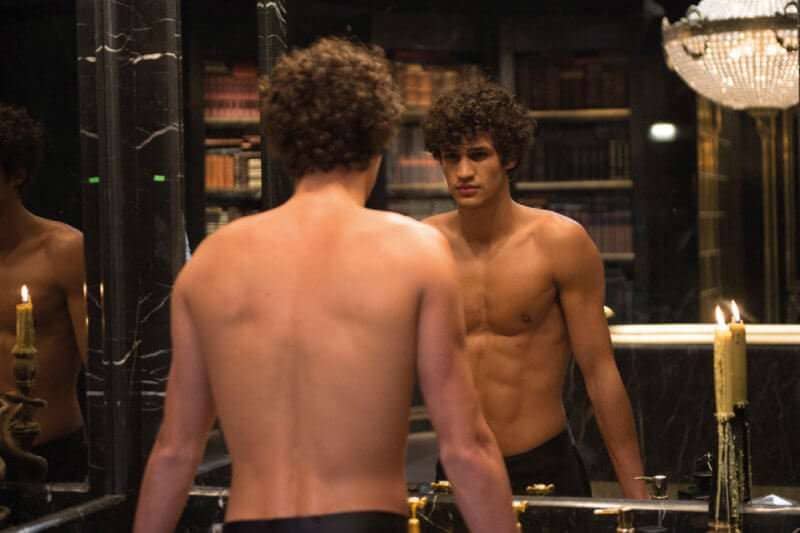The Narcissus myth about the beautiful, doomed youth who falls for his own reflection continues to be a mainstay of this Millenium’s advertising – albeit re-written with a ‘happy ending’.
For example, this Pure XS Paco Rabanne TV ad set in a kind of Big Brother bathroom, stars a young, athletic, and voluptuously beautiful man (Francisco Henriques) undressing/stripping for a bath, using the gold tap as a phallic signifier – while admiring himself in the mirror. All the while observed by young women through peepholes and two-way mirrors – admiring his admiration – and camply swooning to the floor as one at the end of the ad when he squirts the product at his groin.
Stinging nads to one side, the ad is a canny comment on – and exploitation of – the starring role of male vanity and ‘objectification’ in our 21st Century selfie-admiring, cam-show culture.
Thanks to a mediated world where everyone carries around a multiplying mirror in their pocket called a smartphone, Narcissus no longer wastes away unable to possess his reflection. He can reproduce himself endlessly on social media, become a sporno hero – and find himself reflected in the gaze of others. Male beauty and male tartiness, once stigmatised as ridiculous or perverted, are the shining, Immaced inspiration of our age — the very symbol of ‘sexiness’.
Which makes it all the more unforgivable that I missed the ad when it first aired last year. I was probably fast-forwarding to the latest instalment of Love Island or Bromans. But not to worry, some 120 people complained to the Advertising Standards authority about it, getting it into the news this week.
Shockingly, they weren’t complaining about the fact that it ends too soon.
Most were upset about the Pure XS ad ‘objectifying’ the young sporno featured voyeuristically in it, claiming it was sexist and offensive for that reason. Apparently, objectification is a bad thing.
Fortunately for the future of spornosexual advertising, the ASA rejected these complaints, and ruled that it was ‘unlikely to cause serious or widespread offence’ – which seems ‘objectively’ true.
However, the basis of the ruling was pure doublespeak. According to the ASA the ad – which like many ads today goes to enormous trouble and glossy expense to serve up the young man as a all-singing, all-dancing SEX OBJECT – even helpfully showing him being perved over by young women – ‘did not objectify the male character’.
But the ASA itself admitted that the commercial:
‘was heavily focused on the physical appearance of the male character. The ad featured multiple shots in which the male character was topless and his expressions when looking in the mirror suggest he was admiring his own physique and attractiveness. We considered that this and the reactions of the women to him placed a strong emphasis on the attractiveness of the male character.’
Well, quite. You could hardly say otherwise. But they then go on to say:
‘However, we noted the scenario depicted in the ad was not realistic and the tone was risque but comedic and farcical. We considered the ad showed the male character’s attractiveness in a light-hearted, humorous way, rather than in a degrading or humiliating manner… we considered, for the above reasons the ad did not objectify the male character.’
It’s certainly true that the scenario depicted in the ad was presented as comedic and farcical – as well as sexualised and objectifying. The ‘light-hearted’ presentation of the ad (and I’m not really sure that sexiness, or multi-million-pound fragrance advertising, is ever really ‘light-hearted’) does nothing to change the fact that it glories in presenting the man as a (very willing) sex-object. The humour may make it more palatable to some, apparently including the ASA, but it does not do away with ‘objectification’. There would be no ad without it.
What the ASA seems to be saying is that the male model was not objectified because it’s not bad objectification. Good objectification, according to the circuitous reasoning behind what is anyway a loaded term, can’t be objectification – because objectification is necessarily bad. When in fact, objectification can be… wonderful. Which is part of the reason why so many young men today work so hard to turn themselves into sexy things.
Which raises the issue that got this ruling a lot of attention in some sections of the press this week, and alerting me to the existence of the ad. It seems likely XS was complained about by people who are not really offended by it but pushing an agenda, or as they might put it, concerned about double standards.
A double standard that holds that objectification of men is either impossible or is good if possible, and objectification of women is bad – by definition. A double standard that, on TV at least, seems to now be the dominant morality – in part because TV tends to be watched more by women than men. Even BBC costume dramas these days are all about the gratuitous topless male tottie. Indeed, things have got so bad of late that I am tempted to actually watch one.
The double standard was underlined by the ASA’s simultaneous ruling – after just one complaint – that an ad featuring an attractive young female tennis player was ‘objectifying’ and therefore upheld the complaint.
The poster ad for Tunnock’s tea cakes (which was placed near a tennis tournament in Scotland) showed an athletic young female tennis player holding a tea cake in place of a tennis ball at the top of her thigh with her skirt raised at the hip. Text underneath stated: ‘Where do you keep yours?’ Then beneath an image of the product the endline: ‘Serve up a treat.’
Explaining why they upheld the complaint the ASA said:
‘We considered the phrase “serve up a treat” would be understood to be a double entendre, implying the woman featured in the ad was the “treat”, and considered this was likely to be viewed as demeaning towards women…’.
‘We considered that although the image was only mildly sexual in nature, when combined with the phrase “serve up a treat” it had the effect of objectifying women by using a woman’s physical features to draw attention to the ad.’
‘In light of those factors, we concluded that the ad was likely to cause serious offence to some consumers and was socially irresponsible.’
The Tunnock’s tea cake ad is, like the product itself, very 1970s. It is not nearly as glossy or expensive or indeed as playful or as knowing or well-made as the Paco Rabanne ad. And it isn’t, for my money, very funny. I’m not sure though that any of these points are sufficient reason for calling it ‘socially irresponsible’.
You could argue that it is ‘more’ objectifying than the Rabanne ad because of its disembodied nature (the shapely thigh has no face) – and because of the history of female objectification.
But the ASA doesn’t argue this. It doesn’t accept, remember, that the Rabanne ad is objectifying at all. Difficult not to conclude that the main difference that the ASA is interested in here is that one objectifying ad features a man, the other a woman. Indeed, if the tennis player had been a man wearing a kilt with the same text and the teacake in the same place, I have a hunch the ASA would not have upheld the complaint. Or at least, I certainly hope not.
It upheld the complaint about the Tunnock ad on the grounds that it ‘uses a woman’s physical features to draw attention to an ad’. But that is precisely what the Paco Rabanne ad does with a man’s physical features – and at greater, HD length. Though granted without the cringe-making copywriting.
The strongest grounds the ASA has in censuring the sticky ad and not the smelly one is that it ‘bore no relevance to the advertised product’. Paco Rabanne, like most fragrances, is associated – or tries very hard to associate itself – with sensuality and sexuality. But this doesn’t seem to be a major part of the ASA’s ruling. And anyway, there are all sorts of products pushed in prime time by attractive, mostly naked young men in ads that don’t bear much relevance to the product – or tin mining in 18th Century Cornwall.
Interestingly, some of those 120 complaints about the aftershave ad claimed it was ‘sexist’ because it ‘depicted women as powerless and weak and therefore reinforced stereotypes’.
These complaints were also not upheld. The ASA’s explanation points out that the women are ‘in a position of power over the male character’ because they are voyeuristically watching him, possibly unseen. Again, admitting in effect that the young man is objectified – despite asserting in their first ruling that he is not.
‘We considered because the women were seen to be watching the man, perhaps without his knowledge, it suggested they were in a position of power over the male character. We noted as the ad progressed and the male character was in various stages of undress, it was evident from the reactions of the women depicted they were increasingly being overcome with excitement. We further noted during one of the final scenes, all of the women were seen to have fainted and collapsed at the sight of the man spraying the fragrance towards his groin.’
The ASA ruled that the surreal and farcical nature of the ad meant it was unlikely to reinforce stereotypes of women and concluded it was unlikely to cause serious or widespread offence. Which essentially means: only an idiot would take the fainting seriously.
I would add that the women’s voyeuristic enjoyment of the young man and their very visible arousal over him show that
a) The ad is depicts the women as having very active, almost perverse, sexual appetites, which is about as contrary to stereotypical portrayals as you can get
and
b) Their ecstatic response to his tarting shows that being ‘objectified’ can be very powerful. Which of course further undermines the ASA’s notion that it’s necessarily ‘bad’.
I’m not sure that I should be bringing any of this up though. All drawing attention to the possibility of a double standard here is likely to achieve is the banning of male objectification as well as the female variety – for the sake of ‘equality’.
And that would be horribly cruel. Narcissus really would wither away then.
Postscript: My chum Simon Mason helpfully pointed out something I’d forgotten – that the Pure XS ad is rather similar to a German ad I wrote about a few years back, which features a young sporno taking a bath, spied on by the camera/us, a voyeurism he seems to approvingly acknowledge towards the end:
Update May 2019
Jose Arroyo kindly pointed out the soundtrack for the ad is the Habanera from Bizet’s Carmen – an aria that Carmen sings in answer to the young men flirting with her outside the factory where she works:
Love is a rebellious bird That none can tame, And it is well in vain that one calls it, If it suits it to refuse. Nothing to be done, threat or prayer; The one talks well, the other is silent, And it's the other that I prefer; He’s silent but I like his looks. Love! Love! Love! Love!



